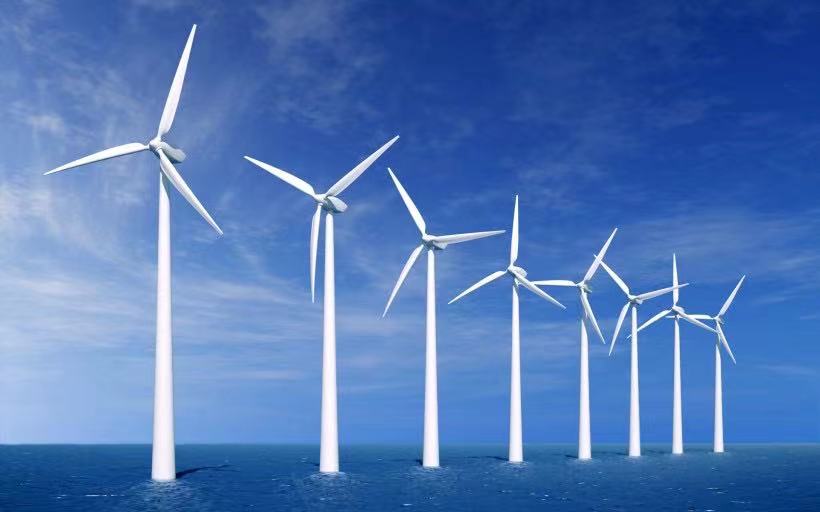
The manufacturing end is the main emission source:
According to the data released by Wood Mackenzie, in the whole life cycle of the wind farm, carbon emissions mainly come from the upstream manufacturing end, the mining of metal raw materials such as steel, aluminum and copper. The total carbon dioxide emissions from the wind turbine manufacturing process account for about 86% of the carbon emissions of wind power.
The reporter learned that in the wind power industry, steel is mainly used in tower, engine room cover and other components, while cables, control wires, submarine cables and motor equipment in wind farms are the main copper application scenarios. Wind power is a form of clean energy that uses the most copper as raw material. Previously, energy monitor, an international industry research institution, released data that, based on one megawatt of power generation, the copper consumption of offshore wind power can reach 8000 kg, while that of onshore wind power is about 2900 kg.
It is predicted in the industry that with the rapid increase of global onshore and offshore wind power installations, metal consumption will also rise rapidly. In addition, in recent years, the height of wind power tower in China has also been increasing. Some analysts believe that the development of high tower technology may lead to higher steel consumption.
In addition, Wood Mackenzie data also shows that about 14% of the carbon emissions in the whole life cycle of the wind farm come from transportation, hoisting, operation and maintenance, and wind turbine equipment disposal after the wind farm is retired. In addition, up to now, the retired fans in the world are still unable to achieve 100% recycling, and the fan blades are difficult to reuse because of their special materials. It is not uncommon for a large number of blades to accumulate into pieces of garbage.
Several enterprises announced the goal of "carbon neutrality":
Does the huge consumption of raw materials and high energy consumption at the manufacturing end greatly reduce the "green" attribute of wind power? A number of insiders told reporters, "That's not the case.".
"The carbon emissions during the operation of wind farms can be basically ignored, which can be seen as a zero emission process. Even from the perspective of the whole life cycle, the emission reduction effect of using wind power to replace fossil energy power generation must be far higher than the greenhouse gas emissions from wind turbine manufacturing itself." Li Dan, Executive Secretary General of the Renewable Energy Professional Committee of the China Association for Circular Economy, told reporters.
Is this really the case, and how should we define the carbon emissions generated by the wind power industry?
Chen Zhibin, director of investment, financing and international business of Beijing Zhongchuang Carbon Investment Technology Co., Ltd., said in an interview with our reporter: "From the perspective of the carbon market, the wind power industry mainly considers the carbon emission reduction in the operation phase. High energy consuming industries such as power consumption, steelmaking and electrolytic aluminum at the upstream manufacturing end are one of the main areas of carbon market control. If the wind power industry also takes this into account from the perspective of carbon emissions throughout the life cycle, double counting may occur."
"But on the other hand, many wind power enterprises have put forward the goal of 'carbon neutrality'. It is worth encouraging to do carbon management by themselves and reduce the carbon footprint of the whole life cycle. I think this is a plus for enterprises and a manifestation of their social responsibility." Chen Zhibin added.
The reporter learned that many wind turbine manufacturers around the world and major wind power developers in China have successively announced the goal of "carbon neutrality". On July 21, Siemens Gomesa, a wind turbine manufacturing giant, announced that it would produce "waste free fans" by 2040 and achieve the goal of net zero emissions in the whole value chain by 2040. Vestas, another wind turbine manufacturing giant, also launched the "wooden tower" in July to achieve emission reduction. Once the wooden tower is put into use, the company is expected to achieve the goal of reducing carbon emissions per megawatt hour of electricity produced in the entire supply chain by about 45% by 2030. China's wind turbine manufacturer Mingyang Smart Energy, Vision Energy and other enterprises also announced the "carbon neutral" schedule.
Decarbonization of the whole industrial chain is more important:
"If China's carbon market includes high energy consuming industries such as steelmaking, the pressure on iron and steel enterprises to reduce emissions will certainly be transmitted to the downstream. Once the cost of carbon emissions appears, it may be reflected in the way of rising product prices and transmitted to the wind power industry in a market-oriented way." Li Dan said, "There will not be only one link in the process of carbon reduction affected."
Wood Mackenzie pointed out that "green" steel and concrete manufactured by low-carbon technology will become an important part of the wind power industry's emission reduction. At the same time, increasing the use of renewable energy power in the manufacturing process and using electric vehicles in the transport sector can further reduce carbon emissions. In addition, the technical progress of fans will also help to improve the durability of fans, thereby reducing the on-site operation and maintenance needs.
"From the perspective of the whole society, we need to work towards carbon reduction. In fact, it is difficult to fully achieve carbon neutrality when others are not 'carbon neutral'. But the renewable energy industry can do more, and has greater responsibility in emission reduction." Li Dan said.
In Chen Zhibin's opinion, for the wind power industry, there are many ways to achieve the goal of carbon reduction, but the current goal of carbon peaking and carbon neutralization is more of a market opportunity for wind power, and it is more important to expand installed capacity and do a good job in stabilizing power generation.

